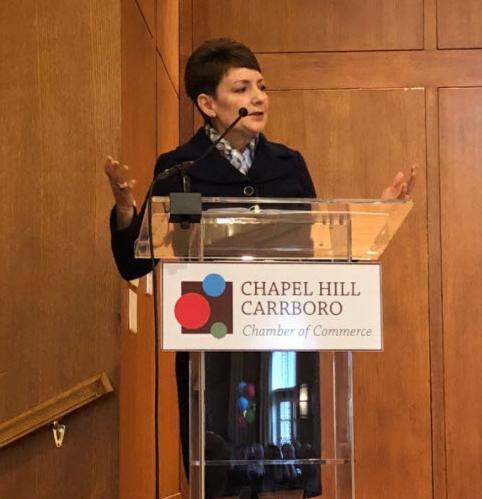Building the Energy Grid of Tomorrow
Duke Energy CEO Lynn Good shares company’s grid modernization plans

Roads, railways and broadband might come to mind when you hear the word “infrastructure,” but at Duke Energy, the first thing that comes to mind is the energy grid – the largest machine ever built. It’s the infrastructure that powers nearly every part of society, enabling communities to grow, businesses to thrive and families to live comfortably.
While it is among the 20th century’s most amazing engineering feats, it remains surprisingly unchanged. To meet increasing energy demands and customer expectations, energy companies including Duke Energy are investing in modernization that will make the industry greener, smarter and more capable for the 21st century.
Duke Energy President and CEO Lynn Good recently spoke to the Chapel Hill-Carrboro Chamber of Commerce, a group of North Carolina business leaders familiar with the importance of infrastructure and the investment Duke Energy is making in the state. Highlights from her speech:
Customer-centric communication
The energy grid was built as a one-way highway where energy companies generate electricity and deliver it to customers, Good said. It wasn’t built for today’s customer, who wants information about energy efficiency, outage status updates and personalized communication.
“It means more billing options. It means more information for you,” Good said. “It means a mobile app so that you can be engaged on what your energy needs are and what energy you’re using so that you can make choices that work for your family.”Modernization allows the grid to operate like a multilane highway where energy and information can flow in both directions between the company and customer. And smart meters are part of the modernization process. Duke Energy installed about 1.2 million smart meters over the last several years and plans to install another million in 2018 across its service territory.
Generating cleaner energy
The multilane highway also allows for something else customers are asking for: cleaner energy sources. With a modern grid, customers will have more opportunities to generate their own solar energy, and the grid will be able to accommodate larger amounts of renewables produced by energy companies, too.
Duke Energy’s carbon emissions are down 31 percent since 2005 thanks to a combination of natural gas and renewables along with its nuclear fleet, and the goal is to reduce carbon emissions by 40 percent by 2030. The company plans to achieve that goal by adding more natural gas capacity, continuing pipeline construction and adding more than 2,600 megawatts of solar in the Carolinas alone.
Increasing reliability
Over the next 10 years, the company will upgrade the system to make service more reliable. Good said the company is already installing technology that can automatically detect, isolate and reroute power when a problem occurs. Duke Energy plans to make 80 percent of its grid self-optimized. It will also bury power lines that are prone to outages. Duke Energy is analyzing data to determine which lines are the best candidates and has already identified 10,000 miles of lines in the Carolinas.
“We understand what it takes to light the night, and we understand what it takes to keep you warm in the wintertime,” she said. “And so that perspective is we want to bring to the conversation … so that we can make the right decisions for the right infrastructure at the right pace, at the right price, to achieve the objectives of growth and stewardship that are so abundant in North Carolina.”

